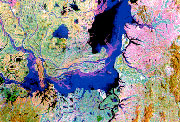|
Fluvial Lakes
The forming of fluvial lakes is often closely related to the development of the river and river course change. They are mainly distributed in the plain area. Owing to the influence of the rise and fall of the topography and the change of runoff, the river course moves frequently, and forms many types of fluvial lakes. This kind of lake generally has a winding strandline, the lakebed is shallow and flat, and the lake is relatively shallow.
The forming process of a type of tectonic lakes-the rift lake is:
 the river flows and has tributaries to join. The areas near the river and its tributaries are mostly plains, and sometimes perhaps some mountain regions or the hills; the river flows and has tributaries to join. The areas near the river and its tributaries are mostly plains, and sometimes perhaps some mountain regions or the hills;
- because the river course move and swing, there leaves the lake by the river course, and it becomes the fluvial lakes;
- sometimes the river course is silt up, and accumulates water to form the fluvial lakes;
- because there are rivers pouring into the fluvial lake, the lake can expand during the wet season.
- when the water budget is balanced, the form of fluvial lakes becomes relatively steady. However, when there is a bigger change for the water budget, the fluvial lake is changeful in shape.
China has a vast territory, and there are many types of fluvial lakes. Here the five major types are selected as followed.
 (1) Because the silt carried by the river piles up evenly on the flooded plain, and results into the water accumulating between natural banks and the lakes are formed accordingly. The lake group (such as Honghu Lake), near the Yangtze River and Hanshui River in Hubei Province, and the lake group in Hebei Province (such as Baiyang Lake, Hechenghu-fig1), both belong to this kind of lake. (1) Because the silt carried by the river piles up evenly on the flooded plain, and results into the water accumulating between natural banks and the lakes are formed accordingly. The lake group (such as Honghu Lake), near the Yangtze River and Hanshui River in Hubei Province, and the lake group in Hebei Province (such as Baiyang Lake, Hechenghu-fig1), both belong to this kind of lake.
(2) The tributary river system can not enter the main stream and is cut off from it due to the silt. Therefore, the tributary accumulates water and forms the lake in a strip form. For example, the City West Lake and City East Lake in the valley of the Huaihe River, Anhui Province are formed due to the river block in the 1830s and 1840s .
(3) The runoff of the tributary river system can not flow freely due to the withstanding effect of the mainstream, and even the latter will pour into the former inversely. Consequently, the lakes form at the lower reaches of the tributaries due to flooding, like Poyang Lake in Jiangxi Province.
(4) When the flood overflows, the river invades the low-lying lands between the highlands on the bank and forms the river bend. On the bend mouth there has deposited a large amount of silt and forms the levee-dammed lake after the flood steps back, like the Lu Lake in Wuchang County of Hubei Province.
(5) After the Yellow River moved to the south in 1194, the lower reaches of Sishui River were congested, and the river can not let out smoothly, thus storing water and forming a series of lakes. From that on, there spread the Nanyang Lake, Dushan Lake, Zhaoyang Lake and Weishan Lake, called Southern Four Lakes. The Yellow River cut off Sishui River to enter Huaihe River, and not only disturbed the Huaibei river system, but also made Sishui River and Huaihe River silt up seriously and can not let out smoothly. In addition, due to the influence of human factor, there also formed Hongze Lake, Gaoyou Lake, Shaobo Lake and Baoying Lake at the lower reaches of Huaihe River.
Volcanic Lakes <<
Oxbow Lakes >>
|